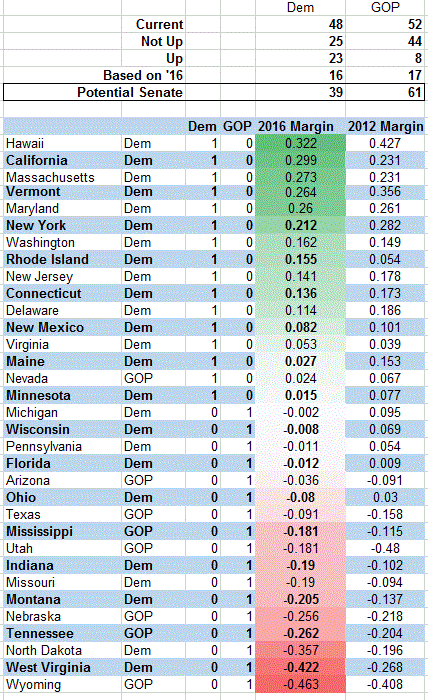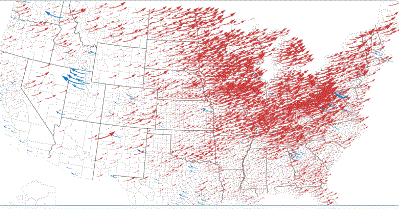There may be some detail I am missing, but I have been looking at the 2018 races.
The judicial filibuster will almost certainly be broken in the new Senate. But much of what the GOP want’s to do can be done via reconciliation.
If the pattern from 2016 holds, the GOP may get to 60 votes in 2018.
This is the cheat seat for the Senate.
A couple of things to say here:
1. The 2018 electorate will not be as friendly as the one in 2016. This is particularly true in the Midwest, where we saw enormous swings from 2012 to 2016. Consider 2014:
Iowa – lost by 8
But the opposite was true in:
Michigan – Peters won by 13, but the Dems lost the governor’s race.
Minnesota – Won by 9.5
Democratic Seats are up in Ohio (Trump won by 8), Pennsylvania (Trump won by 1.1), Wisconsin (Basically a tie, but the GOP won the Gov’s race in 2014 and the Senate race in 2010), Michigan and Minnesota.
This tells me the Democrats need to figure out what happened in the Midwest quickly.
2. I think we can start by assuming the following seats are gone:
North Dakota
Montana
Indiana
Cook says that Montana and Indiana are Likely Democratic, and Indiana leans that way. I don’t agree. The evidence since 2010 is overwhelming: Red State Democrats lose.
Manchin holding on in West Virginia isn’t a foregone conclusion, but I do not include him in this list.
To get to 60 the GOP needs to win, in order of this sheet:
Ohio
Florida
Wisconsin
Michigan
Minnesota.
They also need to hold Nevada and Arizona, which may be fights.
To summarize: There is a long way to go until 2018. But the potential for a GOP stranglehold on the Senate, and on Government, is much bigger than anticipated.
Most, including myself, underestimated Trump.
I would not do that again.




And 36(?) governorships ahead of the census? Sigh. They will be as targeted as Senate seats with 2020 coming up. The filibuster can be gone anytime they want.
If the GOP keeps the filibuster, it will likely be for the same reason that is made regarding Democrats not attempting to win landslides, e.g. they don’t really want to govern. At least, they don’t want to be held 100% accountable for what they’re going to do.
If the filibuster remains, I think it will be because the Republicans realize that they, again, tenuously won the White House and won’t be holding it forever. And I think they also know already that they have enough blue dogs that will vote with them to make their policies “bipartisan” enough that they want the filibuster to continue to exist in 2020/2024.
Republicans have never been, and never will be held accountable for obstruction, and the Democrats always have, and always will be held accountable for not meeting the Republican party 99% of the way.
Ultimately, if the filibuster is destroyed, then we know we’re in for interesting times. The Republican party is all-in with Strongman Trump.
If it remains, then the Republican party isn’t totally going to prostrate itself to Strongman Trump.
I think they’ll keep the filibuster, at least at first, because it allow McConnell to let the Senate Dems stop a policy he doesn’t want to allow but doesn’t want the flack from stopping either – basically, Trump or Ryan idiocies. It also gives him leverage with the Senate Dems because if they block everything he’ll go ahead and nuke it, so he can probably use it to leverage some “bipartisan support” out of them.
This analysis must be done at the county and precinct level to make sense.
A sample of counties in Michigan from 2012 and 2016 shows how interesting this becomes.
Genesee Co. MI 2016 +0.095 2012 +0.281 Change -0.186
Macomb Co. MI 2016 -0.115 2012 +0.040 Change -0.155
Missaukee Co. MI 2016 -0.523 2012 -0.340 Change -0.183
County seats are Flint, Mt. Clemens, and Lake City.
Urban – under emergency management; suburban white flight ring; rural
Did you see the WaPo article: The 500 or so counties that went for Clinton generate almost 70 percent of GDP.
That is a trend–economic concentration.
Something to add to the evidence of “what went wrong” for 2016. Regions where the rate of diversity increased in non-diverse regions:
The increasingly diverse United States of America
Oh to have the data…
One theory I have is that there is a backlash in low diversity communities to an influx of Hispanics. If you look at Iowa, which has one of the biggest swings from 2012, note the low diversity big increase.
There is an area from Nebraska through Iowa and into Minnesota and Wisconsin. A map of the shifts from 2012 shows that same area saw significant swings from 2012 to Trump.
Note the same phenomenon in New Hampshire, rural Pennsylvania and Maine.
Right. “Town isn’t like how it used to be” attitude with anti-immigrant fervor even though in raw numbers the evidence wouldn’t support that + neoliberal economics taking away their means of making a living.
And on an anecdotal basis, all I’ve been hearing while on Thanksgiving Break was “anti police” fervor and people pissed at Obama for “taking sides”. Could correlate with that map, too.
Seabe – I am going to write in detail about this elsewhere – your map though I had suggested the idea before – so I will not if you are going to because your map confirmed what was nothing more than a guess.
Anyway, from a study on Britain:
“using an indicator of affective attachment, the findings suggest that changes in community diversity do lead to changes in attitudes towards the community. However, this effect differs by whether the change in diversity stems from a community increasing in diversity around individuals who do not move (stayers) or individuals moving into more or less diverse communities (movers). Increasing diversity undermines attitudes among stayers. Individuals who move from a diverse to a homogeneous community report improved attitudes. “
http://esr.oxfordjournals.org/content/early/2015/08/20/esr.jcv081.full
In Iowa, many small towns have seen a large influx of Hispanics as a result of a single large employer.
https://t.co/fDf5YlEFkC
Robert Putnam, a liberal professor at Harvard has noted lower trust in diverse communities, though his analysis has been disputed.
As a general statement I have my doubts. But as description for the reaction it may make sense.
I am plowing into the research.
But I think this does explain something. Perhaps quite a bit.
Compare your map to a map of the shifts in vote:

Correlation does not mean causation.
But damn.
And, from a Pew Poll from 2008:
Note:
http://www.pewsocialtrends.org/2008/12/02/americans-say-they-like-diverse-communities-election-censu
s-trends-suggest-otherwise/
I assume they study actual cases – i.e. reactions to change in population. and varying size of the cities/ towns and the condition of the social fabric also pertain. for example, in some states, where towns have been devastated by factories moving away, any change add fuel to the fire. other instances, fairly prosperous small towns with intact social fabric may absorb changes in population easily
NYTimes December 21, 2001 — Meatpackers’ Profits Hinge On Pool of Immigrant Labor
Perhaps the change in the past fifteen years has been these workers establishing their own communities (families, shops, churches) which made them more visible to the white people in the area. Also more recently the diversity of workers in these industries increased to include immigrants from South America, Africa, and Asia.
I think there may be a point where a community becomes large enough and that causes a reaction.
I’d seen the research on the industry recruiting in Mexico, the conditions and danger. chicken or egg? which came first? usa citizens rejecting the jobs, or the cos offering $6 per hour instead of a secure union wages?
the area you mention has high employment due to ag base, economic stress is that affecting middle class life in general, it is paradigmatic of the problems
I think the backlash, if existent, is connected with other factors, maybe attaches itself to influx of immegrants because ppl don’t know how to explain their downward mobility. Compare, for example, life today with the previous generation. that comparison is omnipresent, and distressing even in high employment ag communities. prosperous previous generation has been replaced by struggling generation and there are multiple factors at work
Yeah, saw a mention of that this morning. Did not keep the link, but I was shocked–Hispanics are so mainstream here in the Sun Belt.
I think the deep South learned a lesson when their crops rotted in the fields a season or two.
Seems I remember the Midwest practically giving away housing to anyone who would move there… Anyone else remember that? Did it cause an influx?
Fascinating map. The specifics as to the big change in those low diversity counties might also be revealing.